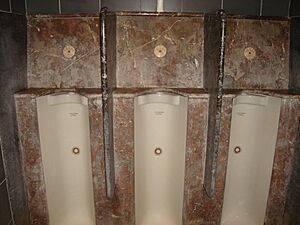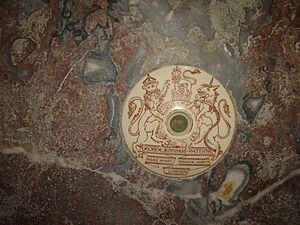George Jennings facts for kids
George Jennings (born November 10, 1810 – died April 17, 1882) was an English engineer and plumber. He is famous for inventing the first public flush toilets.
George Jennings was born in a place called Eling, near the New Forest in Hampshire. He was the oldest of seven children. He learned about plumbing and business from his family. In 1831, he started working as a plumber in London.
He got married twice and had several children. In 1838, Jennings started his own business in London. He used money he inherited from his grandmother to do this.
Jennings was very good at designing toilets that were "as perfect a sanitary closet as can be made." But he also worked on bigger public projects. He designed underground public toilets. These places had fancy entrances with metal railings and lamps. Inside, they were built with slate and later with ceramic tiles.
One of Jennings's most famous projects was for The Great Exhibition in 1851. He installed his special toilets in the Crystal Palace. Sadly, these original toilets don't exist anymore.
Amazing Achievements
1847: Early Success
Prince Albert gave George Jennings a special medal. This was for his clever rubber taps and tubes used for water supply. By this time, Jennings was doing very well. He also started a pottery company in Dorset. This company made water closets, drainage pipes, and other bathroom items. His pottery even had its own steam train!
1851: The Great Exhibition and "Spending a Penny"
At The Great Exhibition in Hyde Park in 1851, George Jennings put his "Monkey Closets" in the public restrooms. These were the very first public toilets, and people were very excited about them!
During the exhibition, over 800,000 visitors paid one penny to use them. For that penny, they got a clean seat, a towel, a comb, and even a shoe shine. This is where the famous saying "to spend a penny" for going to the toilet came from.
When the exhibition ended, Jennings convinced the organizers to keep the toilets open. They ended up making a lot of money! Jennings believed that "the civilisation of a people can be measured by their domestic and sanitary appliances." Some people disagreed, saying visitors weren't there just to wash!
(It's important to know that Thomas Crapper, who many people mistakenly think invented the flush toilet, was only 14 years old at this time.)
1852: New Inventions
On August 23, 1852, George Jennings received a patent for his new inventions. A patent is like a special permission that protects an invention. His patent included:
- A new type of water-closet where the bowl and trap were made in one piece. This design always kept water in the bowl.
- Improved valves for water-closets and other uses. These valves made it easier to control the water flow.
- A new type of trap for drains.
- A better way to build pumps for lifting water.
- A new method for making pump barrels stronger by adding a brass lining.
1854: First Underground Public Toilet
George Jennings designed the first underground public toilet. It opened at the Royal Exchange in London.
1855: Helping During War
During the Crimean War, Jennings led a special team. The British government sent them to improve the hygiene at a hospital in Turkey. This was at the request of Florence Nightingale, the famous nurse.
1860s-1870s: Global Reach
In the 1860s, Jennings started selling his products all over the world. He supplied a fancy mahogany shower cabinet to the Khedive of Egypt. He also provided a beautiful copper bath to the Empress Eugenie of France. In 1870, he installed his patented flushing toilet in a famous castle, Cardiff Castle.
1872: Royal Recognition
George Jennings oversaw the public facilities for a special thanksgiving service. This service was for the Prince of Wales (who later became King Edward VII). The Prince had recovered from typhoid. Jennings was a favorite of the late Prince Consort, who had encouraged his work. A newspaper at the time said Jennings was a leader in sanitary science. He even offered to make public toilets free in London, as long as attendants could charge a small fee for using them and towels.
1882: The End of a Life
George Jennings died on April 17, 1882, when he was 72 years old. He had an accident while driving his horse and cart. He broke his collar bone. He was recovering well, but then he got up against his doctors' orders. He had a relapse and passed away. He was buried at West Norwood Cemetery. He left behind a large fortune.
After His Death
Jennings's family business continued for many years, until 1967. By 1895, their catalog showed that they had installed public toilets in at least 36 towns. They also supplied toilets to cities like Paris, Florence, Berlin, Madrid, and Sydney. Their products were used in South America and the Far East too. They provided water closets to many railway companies in Britain, America, Argentina, Mexico, and South Africa. Their catalogs were thick books filled with all sorts of water closets, urinals, basins, baths, and even Turkish baths.
Awards After His Passing
Even after his death, George Jennings's work continued to win awards.
- In 1884, at the International Health Exhibition in London, his "Pedestal Vase" toilet won a Gold Medal. This toilet was tested and could flush down ten apples, a sponge, and paper with just two gallons of water!
- In 1900, his company won the Grand Prix in Paris for his siphonic pan. This was a big step forward in toilet design.
Some of His Designs
- Jennings's Patent Tilt-up & Lipped Lavatory
- Jenning's and Lovegroove's Patent Plunger-Closet (1858)



